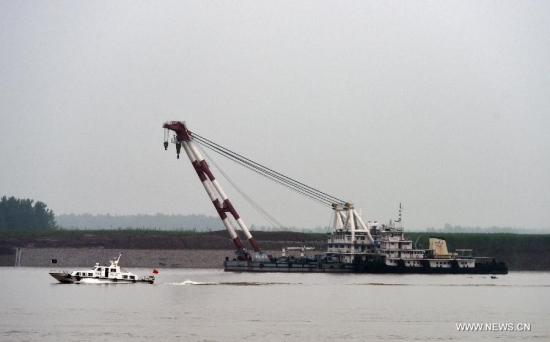
A crane vessel waits for rescue work near the site of capsized passenger ship Eastern Star on the section of Jianli of the Yangtze River, central China's Hubei Province, June 4, 2015. (Xinhua/Li Ga)
Latest:
Death toll rises to 77
By 18:00, 77 bodies had been recovered, 14 people survived, while more than 300 are still missing, CCTV reports.
Death toll from the capsized ship in Yangtze River has climbed to 75, according to information from a press conference organized by the rescue headquarters Thursday afternoon.[Special coverage]
A total of 89 people have been found, including 14 survivors, after the cruise ship with more than 450 onboard capsized on Monday night. The rescue effort is ongoing.
Rescuers cut a 55-by-60-cm rectangular hole on the bottom of the overturned ship Wednesday night to give divers easier access to the hull.
The rescuers have opened three holes in the hull to reach more than 370 people who could still be alive in the ship.
Air pockets could have formed at the bottom of the ship when it overturned quickly, said Li Qixiu, an expert with the Naval University of Engineering, which has participated in the rescue effort.
"If trapped in the air pocket, passengers could still have a chance of surviving," Li said, adding that a 65-year-old woman and a 21-year-old survivor were pulled out alive from the air pocket.
However, Li warned that oxygen at the bottom of the ship could grow thinner over time, leaving the survival of those trapped at risk.
"Opening holes on the hull is the last resort in finding survivors in the ship," said Wang Zhigang, general manager at the Wuhan branch of China Classification Society, who is directing the rescue. "If there is sign of life, they should open a hole to rescue. If not, the hole should be closed immediately."
Wang added that, according to international norms, the first 72 hours are the critical period when rescuers should exhaust all means to rescue survivors.
If the first 72 hours pass and no survivors are found, Wang said, turning the ship back upright shows respect for those who have perished.
"After all, their bodies shouldn't be in the water for too long," Wang said.
















































